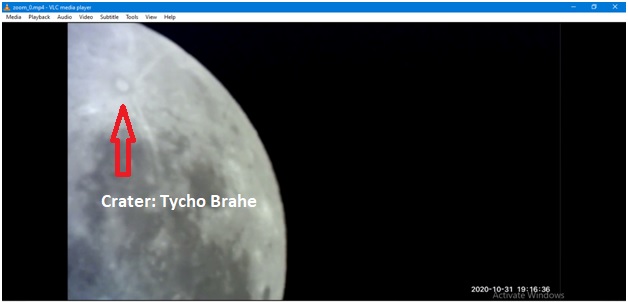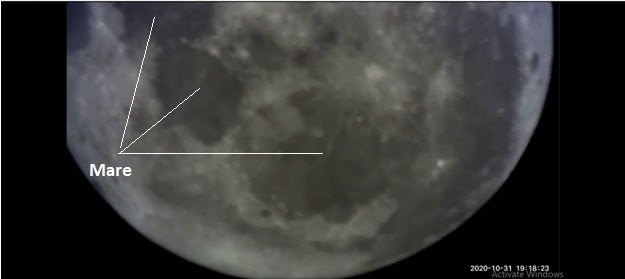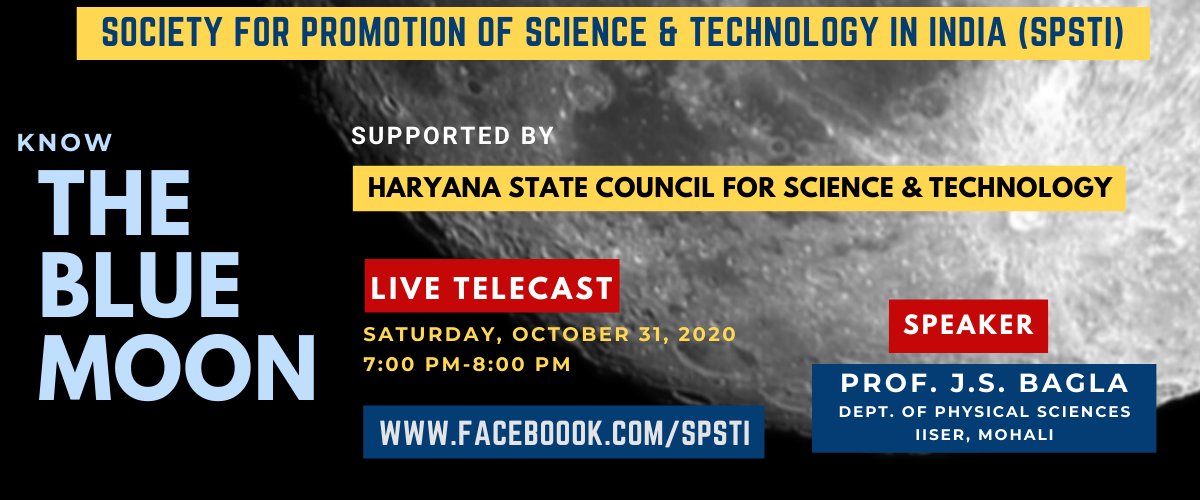The Society for Promotion of Science & Technology in India (SPSTI) is conducted an online astronomical session on October 31, 2020. The session covered basic information about the moon and the live view of the surface of moon as captured by the telescopes were streamed. The event is supported by Haryana State Council for Science, Technology & Innovation.
Speaker: Prof. Jasjeet S. Bagla, Department of Physical Sciences, IISER Mohali
The lecture delivered by Prof. Bagla is transcripted for the readers as below.
What is Full Moon?
Today happens to be second full moon in the calendar month and this happens once in a while. This does not have any astronomical or astrophysical significance but it is a curiosity and because it does not happen very often that is origin of the phase once in blue moon. In a full moon, the earth, sun and moon are approximately in a straight line. If they are actually in a straight line, it happens to be a lunar eclipse but typically we have a full moon. If you look at the astronomical alumna, you will find that it is not hundred percent full but 99.2 to 99.4 percent and the reason for that is again that they are not in an exact straight line. The other interesting thing, the moon revolves around the earth in a slightly elliptical orbit. It is not a circular orbit and the rotation period and the orbital revolution periods of the moon around the earth are identical. So we normally teach school children that because of this reason the moon always shows the same face to observers of the earth. However, this is not strictly true because moon is in an elliptical orbit around the earth and therefore its orbital speed is not same; sometimes it is little bit faster and sometimes it is little bit slower and as a result we end up seeing more than half of the surface of the moon sitting on earth. If you look around you will be able to find the pictures of the moon and there are slight differences in the appearances of the surface of the moon.

Crater: Tycho Brahe
You see a very bright crater on the surface of the moon from where white rays of kind shooting out which can be seen on the top left of the image shown above. This a crater named after the famous astronomer Tycho Brahe. There was a huge rock which must have struck the moon. So on and around the full moon, the Tycho crater and the ray system is the most prominent feature that is visible if you look at with a telescope or capture images with a camera. The dark patches are called Mare.
In the image below, you can see a large number of craters and a large number of Mare and there are bright white ridges which can also be seen. Just like I mentioned for Tycho, there is a system of rays shooting out, even for smaller craters that is visible. So the craters are supposed to have formed because meteors and small asteroids struck the surface of the moon leading to formation of the craters.

Craters which are near the equator of the moon get to see the full sun at some stage or the other whereas the craters closer to the poles do not always get to see the full face of the sun. So there are many craters near the north and south pole of the moon which always remain the dark and these are interesting places because these would not have been heated and cooled so much so they retain original material at early stage.
Changes in Appearance of Moon
If you observe same part of the moon on different days with the telescope, because the orientation of the sun changes, the appearance of every part of the moon changes quite significantly. And, in fact on the day of full moon, you cannot see the edge between the darkness and the light whereas on other days you can see the edges especially after the third day (Tritya) all the day up to the tenth or eleventh day, you can see the line between the bright side and the dark side very nicely and it is near this that the sun’s rays are coming at the slanting angle and therefore the appearance of the craters change very rapidly. Students can try to see if they can work out the simple geometry about the appearance of the shadow inside craters and use that to measure the depth of the crater from its top. That is a simple exercise which a high or senior secondary school student can work out.
The dark surfaces are what I was referring to somewhat as flat areas which have sandier surface which have not seen any crater formation for a long time and therefore the reflectivity in these parts is not varying much from one place to the other. In fact if you look at the large Mare there is white streak in the middle of that and other than that, it is very uniform. So these are flat areas on the surface of the moon.
Hilly and crater areas are the ones which have strong variation in brightness. So you can see very bright patches and you can also see streaks and you can see smaller dark spots in other places. So these are called seas, nothing to do with water, no real sea. These were named as Mare long ago much before the discovery of the telescope.
Question and Answer Session
Question: Recently, it was in news that water has been detected on the surface of the moon. Can you please throw some light on it.
Prof. J.S. Bagla: What they have found that there is small amount of water which is even there in the sun lit part of the moon. If you remember ISRO and NASA had claimed discovery of water but that was in craters near the poles which do not get to see the sun and so it was not clear if there is any water content in other parts of the moon. The amount of water is very small. It is like small bottle of water in one cubic meter of lunar soil. So, it is there but not very useful.
Question: How many craters are there on the surface of moon?
Prof. J.S. Bagla: The number of craters is very large. If you want to do a count, you have to specify how many craters are larger than the size of sun, or if you say how many number of craters larger than one kilometer, one will be able to put a count. But as you go smaller in size, the number of craters is very large.
Question: Why is a crater so bright? At least the middle part should be dark.
Prof. J.S. Bagla: The middle of the crater would be dark if it is in shadow. If sunlight is falling, there is no reason for it to be dark. The appearance and the color essentially come from reflectivity and that is related exactly to what is mineral composition of the crater.
We consider moon to be very bright but actually moon is very dark in the sense that reflectivity of the moon is very poor. This is something which was discovered long ago, more than hundred years ago. One astronomer was observing the moon rising, observing from the sea off the coast of Cape Town in South Africa where there is a large flat straight cliff rising out of the sea. By looking at the moon and the brightness of the cliff wall, he realized that the reflectivity of the moon has to be much lower than that of the cliff wall because moon was much darker.
Question: How did the moon gets craters?
Prof. J.S. Bagla: Moon continues to get craters because meteors fall on it. Smaller meteors give rise to smaller craters. The can be of the size of few centimeters or it could be half a meter but there are craters which are more than a kilometer across.
Question: Can we see the impact when a big meteor strikes the moon?
Prof. J.S. Bagla: Yes! But it does not happen very often. Most of the big craters which we see formed long ago. They date back period three billion years ago when a large number of craters formed.
Question: How far is the moon?
Prof. J.S. Bagla: The distance of moon from the earth is 3,84,000 kilometers.
Question: Is there any life possible on the moon?
Prof. J.S. Bagla: Well, firstly you have to define what life is! There is no constant atmosphere but there is release of gases from solid material on the surface of the moon and that keeps on evaporating. So there is no fix atmosphere. But there are some temporary existences of gases around the surface. It is not enough for anything to breathe in. So certainly we would require providing our own supply of air if you want life like humans. If you wanted plant life, again you do need oxygen if you want plants like the ones we have on earth. But one can image some kind of life which is able to process and extract all auxiliary sources from the solid ground without relying on any air. Of course in that case it has to be designed in such a way that it does not lose any of its own material through release of gases or liquids.
Question: Why does the moon has less gravity?
Prof. J.S. Bagla: The gravitational force depends on the mass and size of the object. As the mass of the moon is one-eight of the mass of the earth, the gravity at the moon is lesser than that at the earth.
Question: What are the most common elements found on the surface of the moon?
Prof. J.S. Bagla: Forms of Carbon, Sodium, Magnesium, Calcium, Surphur etc. are present.
Question: Are there any quakes as on the earth?
Prof. J.S. Bagla: As far I know, there are no tectonic plates on the surface of the moon but due to tidal forces of the earth, the interior of the moon gets disturbed to some extent.
Question: What is the temperature at the surface of the moon?
Prof. J.S. Bagla: The area of the moon where sun light falls gets heated up to 200 degree Celsius and temperature can be as low as minus one hundred fifty where sun light does not fall.

